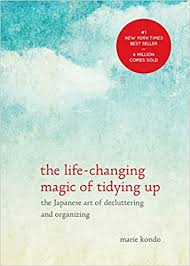
In my Operation Make It Tidy (OMIT) quest, I will share articles and ideas that have given me insight into how to keep the kitchen neat and tidy as I go. To do that, I have to discuss how I came to this point. To those who knew me up to 10 years ago, this would have been a laughable quest. But I have come so far, and the person I can think most for that is Marie Kondo. Here’s how I became a believer and a doer.
One of my great resources that inspires me as a school superintendent is my membership in Consortium 2031, a group of seven school districts all aspiring to be the best they can be. In our spring 2018 meeting in Edina, MN, I was learning at a session on 21st century classrooms. The presenter mentioned a book, The Third Teacher, which focuses on how classroom design can play a major part in helping students learn. The main premise: classrooms should not contain just a lot of really cool stuff and they should not be a ‘shrine’ to the teacher’s interest or passions. Everything in the classroom should be well placed to assist/motivate/inspire/instruct students. There should be nothing extraneous. The presenter mentioned that a major inspiration behind that was Marie Kondo’s famous book, The Life-Changing Magic of Tidying Up. Famous? I had never heard of it! I bought it and read it that night. (Thank you Amazon Kindle! I have paid you dearly, but I do love reading books when I want to read them).
Some of my takeaways and quotes:
- “Tidying is just a tool, not the final destination. The true goal should be to establish the lifestyle you want most once your house is put in order.”
- Discard things when they cease being functional. (Sounds so obvious – but we keep things because we used to love them)
- “We should be choosing what we want to keep.” The rest is what you need to get rid of.
- “Take each item in one’s hand and ask: ‘Does this spark joy?’ If it does, keep it. If not, dispose of it.
- Learning how to fold clothes. Check out Marie’s video on folding clothes. You’ll see – she LOVES this stuff. She talks to her clothes, and to all the things she loves. I use this same technique for dish towels.
- “Clutter has only two possible causes: too much effort is required to put things away or it is unclear where things belong. Yeah . . . I’ll add a third . . . too lazy or uninterested to keep things decluttered, and, in too much of a hurry to get to the next task.
Our bedrooms, our kitchen, our outdoor kitchen, and our living room are now decluttered and Kondo-fied. Our converted garage/playroom is next. I can see every t-shirt in my t-shirt drawer, and I love all of them. My suits and shirts hanging in my closet now have room to breathe, and there’s nothing I don’t wear often. All of my items with holes in them are gone. (That was hard)
And in our kitchen, everything now has a place. There are no clutter drawers. I can see every spatula/peeler/spoon/pan without having to move something that is on top of it. I found complete sets of measuring spoons and cups, and I gave away many measuring spoon and cup orphans. I bought just a few organizers – like these drawer separators from Amazon, which I love. It’s beautiful!
Jill is completely on board. It started off as her watching me de-clutter my closet, wondering who had taken over her husband’s body. And now, she’s completely on board. We are on a first name basis with the good people at the Goodwill stores. I have given the book to members of my family – I don’t know if I have any converts yet. Bur it remains the key to my OMIT quest, and I am grateful to Marie Kondo for setting me on this path.
